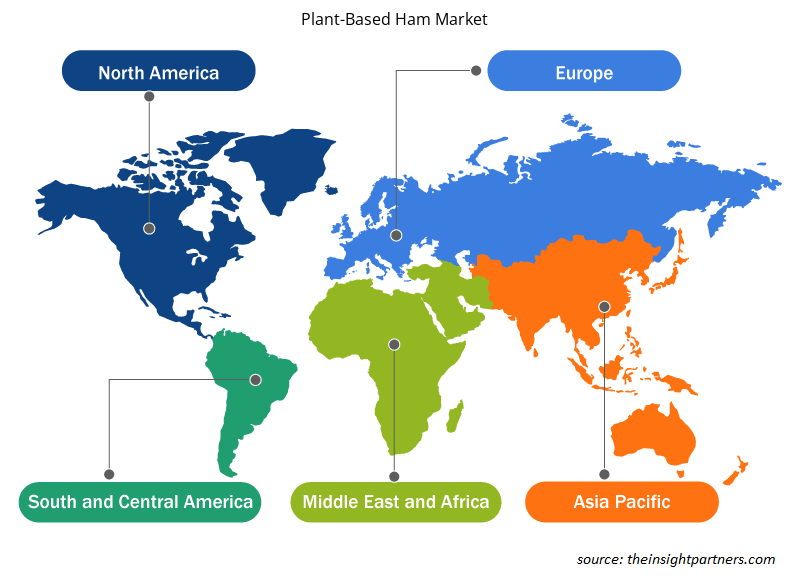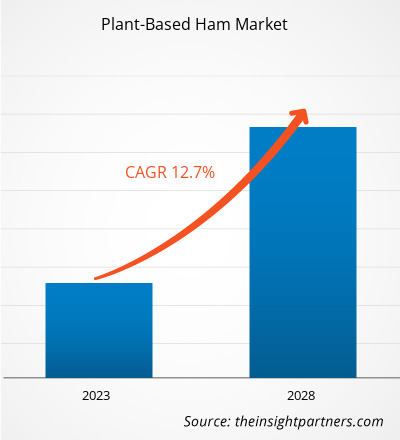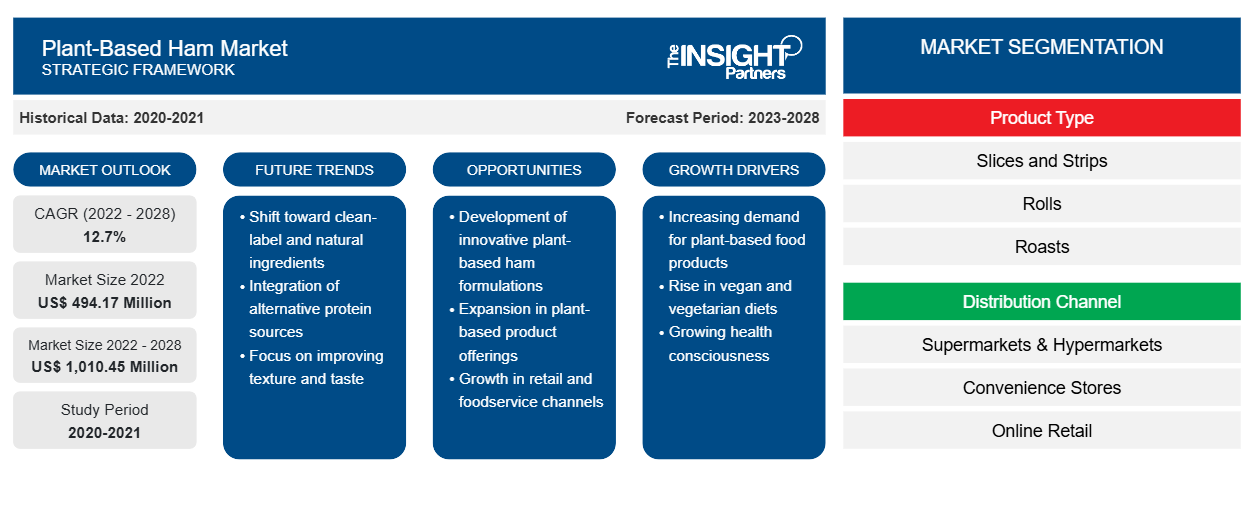Se espera que el tamaño del mercado del jamón de origen vegetal crezca de US$ 494,17 millones en 2022 a US$ 1.010,45 millones en 2028; se estima que crecerá a una CAGR del 12,7% entre 2022 y 2028.
La gente está cambiando rápidamente a productos cárnicos de origen vegetal debido a la creciente conciencia sobre los efectos negativos del consumo de carne y la industria ganadera en el medio ambiente, y los efectos nocivos del consumo de productos cárnicos procesados en la salud. La producción de productos de jamón de origen vegetal puede ayudar a minimizar la huella de carbono, ahorrar agua y otros recursos naturales y reducir el impacto ambiental general. Estos factores son los principales impulsores del crecimiento del mercado del jamón de origen vegetal.
En 2021, Europa tuvo la mayor participación en el mercado del jamón de origen vegetal . Sin embargo, se estima que América del Norte registrará la CAGR más alta durante el período de pronóstico. El alto valor nutricional de los productos de jamón de origen vegetal, que incluyen rebanadas y tiras, rollos y asados, ha disparado su demanda en América del Norte en los últimos años, especialmente entre los adultos jóvenes. El mercado del jamón de origen vegetal en América del Norte comprende varias empresas emergentes y actores establecidos. Hain Celestial Canada ULC; Tofurky Co., Inc.; Lightlife Foods Inc.; y Vbites Foods Ltd. son algunas de las empresas que operan en la región. Además, las personas de los países de América del Norte son muy conscientes de los efectos nocivos del consumo frecuente de carne debido a importantes iniciativas de concienciación pública y campañas publicitarias. La creciente población vegana es otro factor que impulsa la demanda de productos de jamón de origen vegetal en los países de América del Norte.
Personalice este informe según sus necesidades
Obtendrá personalización en cualquier informe, sin cargo, incluidas partes de este informe o análisis a nivel de país, paquete de datos de Excel, así como también grandes ofertas y descuentos para empresas emergentes y universidades.
-
Obtenga las principales tendencias clave del mercado de este informe.Esta muestra GRATUITA incluirá análisis de datos, desde tendencias del mercado hasta estimaciones y pronósticos.
Impacto de la pandemia de COVID-19 en el mercado del jamón de origen vegetal
Durante la fase inicial de la pandemia de COVID-19, la demanda de jamón de origen vegetal aumentó considerablemente debido a un cambio significativo en las preferencias dietéticas de los consumidores. La Organización Mundial de la Salud (OMS) publicó una guía sobre los productos alimenticios que se deben consumir o evitar durante la pandemia de COVID-19. La guía sugería limitar el consumo de carne roja debido a su alto porcentaje de grasas saturadas. Además, las personas se centraron en reducir su consumo general de carne y cambiaron a dietas vegetarianas y veganas para mejorar su inmunidad, lo que creó una demanda masiva de proteínas alternativas, incluido el jamón de origen vegetal. Sin embargo, las unidades de fabricación se vieron obligadas a permanecer cerradas en 2020 y principios de 2021, lo que provocó una disminución de la producción. Los fabricantes pequeños y medianos enfrentaron desafíos importantes debido a la escasez de materia prima y los bajos niveles de inventario. Esto creó una brecha entre la demanda y la oferta.
La creciente conciencia de la salud entre la población y la creciente conciencia sobre la sostenibilidad ambiental y el bienestar animal fueron factores clave que impulsaron el crecimiento del mercado del jamón de origen vegetal antes del inicio de la pandemia de COVID-19. Según el informe del Consejo Internacional de Información Alimentaria (IFIC) publicado en enero de 2020, el 45% de los consumidores encuestados creían que los productos cárnicos de origen vegetal son más saludables que la carne animal, basándose en la etiqueta de "Información nutricional". Sin embargo, después del brote de COVID-19 en 2020, los alimentos y bebidas y muchas otras industrias enfrentaron desafíos impredecibles mientras luchaban por superar las limitaciones de la cadena de suministro debido a los cierres, las prohibiciones comerciales y las restricciones de viaje. Las interrupciones de la cadena de suministro llevaron a una escasez de materias primas, lo que provocó un aumento en los precios de las materias primas. Según el Departamento de Agricultura de los Estados Unidos (USDA), las interrupciones en las cadenas de suministro dispararon los precios de la proteína de guisante , que es uno de los ingredientes comunes utilizados en el jamón de origen vegetal. Además, las dificultades relacionadas con el transporte de contenedores durante los meses iniciales de la pandemia de COVID-19 contribuyeron a un aumento en los precios del aislado de proteína de guisante de US$ 3,40/kg a más de US$ 5,00/kg.
En 2021, varias economías reanudaron sus operaciones cuando los gobiernos revocaron las restricciones. Se permitió a los fabricantes operar a plena capacidad, lo que los ayudó a superar la brecha entre la oferta y la demanda y mitigar otras repercusiones. Además, un gran porcentaje de ciudadanos de varios países estaban completamente vacunados a fines de 2021. Se espera que estos factores brinden oportunidades de crecimiento rentables a los productores de jamón de origen vegetal en los próximos años.
Perspectivas del mercado
Desarrollos estratégicos de los actores clave del mercado para impulsar el mercado del jamón de origen vegetal durante el período de pronóstico
En septiembre de 2022, Quorn Foods Ltd lanzó una gama de lonchas veganas de delicatessen denominadas Yorkshire Ham, Finely Sliced Ham y Roast Beef o Roast Chicken Style Slices. Los productos son lonchas estilo carne listas para comer, ideales para sándwiches, ensaladas y wraps.
Información sobre el tipo de producto
Según el tipo de producto, el mercado del jamón vegetal se segmenta en lonchas y tiras, rollos y asados. El segmento de lonchas y tiras tuvo la mayor participación de mercado en 2021. Sin embargo, se espera que el segmento de asados registre la CAGR más alta entre 2022 y 2028. La forma en lonchas del jamón vegetal proporciona una sensación tierna en boca. Estas lonchas se calientan más rápido debido a la gran superficie expuesta y liberan sabores de forma distintiva cuando se utilizan en preparaciones alimentarias. Además, debido a su amplia gama de consumo, las lonchas y tiras de jamón vegetal están ampliamente disponibles a través de varios canales de distribución. Estos factores están impulsando significativamente el crecimiento del mercado en el segmento.
Información sobre el canal de distribución
Según el canal de distribución, el mercado del jamón vegetal se segmenta en supermercados e hipermercados, tiendas de conveniencia, venta minorista en línea y otros. El segmento de supermercados e hipermercados tuvo la mayor participación de mercado en 2021, mientras que se proyecta que el segmento minorista en línea registre la CAGR más alta durante el período de pronóstico. Los supermercados e hipermercados son grandes establecimientos minoristas que ofrecen una amplia variedad de alimentos y bebidas, comestibles y otros bienes de consumo. Los productos de varias marcas se organizan en secciones separadas para una compra conveniente. Además, los supermercados e hipermercados se enfocan en maximizar las ventas de productos para aumentar los márgenes de ganancia. Por lo tanto, estas tiendas ofrecen atractivos descuentos, múltiples opciones de pago y una mejor experiencia del cliente.
Perspectivas regionales del mercado del jamón de origen vegetal
Los analistas de Insight Partners han explicado detalladamente las tendencias y los factores regionales que influyen en el mercado del jamón vegetal durante el período de pronóstico. Esta sección también analiza los segmentos y la geografía del mercado del jamón vegetal en América del Norte, Europa, Asia Pacífico, Oriente Medio y África, y América del Sur y Central.

- Obtenga los datos regionales específicos para el mercado de jamón de origen vegetal
Alcance del informe de mercado del jamón de origen vegetal
| Atributo del informe | Detalles |
|---|---|
| Tamaño del mercado en 2022 | US$ 494,17 millones |
| Tamaño del mercado en 2028 | US$ 1.010,45 millones |
| CAGR global (2022-2028) | 12,7% |
| Datos históricos | 2020-2021 |
| Período de pronóstico | 2023-2028 |
| Segmentos cubiertos |
Por tipo de producto
|
| Regiones y países cubiertos |
América del norte
|
| Líderes del mercado y perfiles de empresas clave |
|
Densidad de actores del mercado del jamón de origen vegetal: comprensión de su impacto en la dinámica empresarial
El mercado del jamón de origen vegetal está creciendo rápidamente, impulsado por la creciente demanda de los usuarios finales debido a factores como la evolución de las preferencias de los consumidores, los avances tecnológicos y una mayor conciencia de los beneficios del producto. A medida que aumenta la demanda, las empresas amplían sus ofertas, innovan para satisfacer las necesidades de los consumidores y aprovechan las tendencias emergentes, lo que impulsa aún más el crecimiento del mercado.
La densidad de actores del mercado se refiere a la distribución de las empresas o firmas que operan dentro de un mercado o industria en particular. Indica cuántos competidores (actores del mercado) están presentes en un espacio de mercado determinado en relación con su tamaño o valor total de mercado.
Las principales empresas que operan en el mercado del jamón de origen vegetal son:
- Hain Celestial Canadá ULC
- Compañía Tofurky Inc.
- Alimentos Lightlife Inc.
- Alimentos VBites Ltd.
- Nestlé SA
Descargo de responsabilidad : Las empresas enumeradas anteriormente no están clasificadas en ningún orden particular.

- Obtenga una descripción general de los principales actores clave del mercado del jamón de origen vegetal
Hain Celestial Canada ULC; Tofurky Co., Inc.; Lightlife Foods, Inc.; Vbites Foods, Ltd.; Nestle SA; Quorn Foods Ltd.; Meliora Foods Pty Ltd.; Zebra Food Ltd.; Gourmet Evoution, LLC; y Worthington Food Inc. son algunos de los principales actores que operan en el mercado del jamón de origen vegetal. Estas empresas se centran principalmente en la innovación de productos para ampliar el tamaño de su mercado y seguir las tendencias emergentes del mercado.
Informe Destacado
- Tendencias progresivas de la industria del jamón de origen vegetal para ayudar a las empresas a desarrollar estrategias efectivas a largo plazo
- Estrategias de crecimiento empresarial adoptadas por los actores del mercado del jamón de origen vegetal en los países desarrollados y en desarrollo
- Análisis cuantitativo del mercado de 2020 a 2028
- Estimación de la demanda mundial de jamón vegetal
- Análisis de las cinco fuerzas de Porter para ilustrar la eficacia de los compradores y proveedores en el mercado del jamón de origen vegetal
- Avances recientes para comprender el escenario competitivo del mercado
- Tendencias y perspectivas del mercado, así como factores que impulsan y restringen el crecimiento del mercado del jamón de origen vegetal
- Asistencia en el proceso de toma de decisiones destacando las estrategias de mercado que sustentan el interés comercial.
- Tamaño del mercado del jamón vegetal en los distintos nodos
- Descripción detallada y segmentación del mercado, y dinámica de crecimiento de la industria del jamón de origen vegetal
- Tamaño del mercado del jamón vegetal en diversas regiones con prometedoras oportunidades de crecimiento
- Análisis histórico (2 años), año base, pronóstico (7 años) con CAGR
- Análisis PEST y FODA
- Tamaño del mercado, valor/volumen: global, regional y nacional
- Industria y panorama competitivo
- Conjunto de datos de Excel
Informes recientes
Testimonios
Razón para comprar
- Toma de decisiones informada
- Comprensión de la dinámica del mercado
- Análisis competitivo
- Información sobre clientes
- Pronósticos del mercado
- Mitigación de riesgos
- Planificación estratégica
- Justificación de la inversión
- Identificación de mercados emergentes
- Mejora de las estrategias de marketing
- Impulso de la eficiencia operativa
- Alineación con las tendencias regulatorias























 Obtenga una muestra gratuita para - Mercado de jamón de origen vegetal
Obtenga una muestra gratuita para - Mercado de jamón de origen vegetal